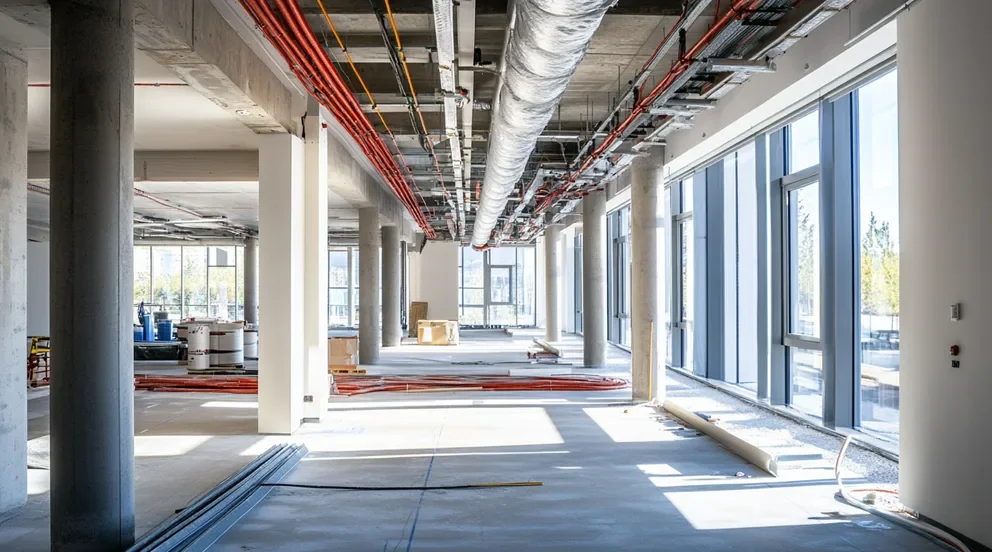**While BuildOps does not currently offer fire pre-plan software, we’re always looking into new and exciting tools and technology that are moving the industry forward, which is why we’re discussing the subject here.**
Fire pre-plan software provides a comprehensive solution for fire departments to store, access, and update data about buildings within their jurisdictions. This data includes information on building construction, hazardous materials, possible entry and exit points, and potential utilities and fire service lines. Such software allows fire departments to plan for efficient fire suppression for any given address or building.
This type of software relies on information and images gathered from both the fire department and the public in order to create a comprehensive plan. Fire departments will often perform visits to receive visual information on a building’s layout and input this into the pre-plan software to create detailed information. Public sources, such as utility companies, can also provide information on the potential water supply, electricity lines, and other assets associated with the building.
The fire pre-plan software provides an invaluable resource for fire departments allowing them to plan efficiently and effectively in the event of fires. This can include determining the best routes to use, the most suitable utilities to call on, and the most efficient entry and exit points. This can often save time and resources at the scene, which can in turn help to reduce the size and scope of fire damage and casualties.
Overall, fire pre-plan software serves as a critical resource for fire departments, providing them with the timely and accurate data they need in order to plan their response to fires in the most efficient way possible.
What are the key features of fire pre-plan software?
Fire pre-plan software is designed to provide an efficient and comprehensive solution for fire departments to store and quickly access information about buildings within their jurisdictions. The key features of fire pre-plan software include:
– Comprehensive Data: Fire pre-plan software provides detailed information on building construction, hazardous materials, possible entry and exit points, and potential utilities and fire service lines. This can save time and resources at the scene, allowing fire departments to formulate the most efficient response plan.
– Visual Building Plans: The software uses images and information gathered from the fire department’s visits, or from public sources, such as utility companies, in order to create a comprehensive pre-plan for any given address or building.
– Customized Fire Response Plans: Fire pre-plan software will generate the best possible routes and actions to take in order to contain the fire efficiently and help minimize damage and casualties.
– Documentation: Fire pre-plan software offers a convenient solution for the storage of all the necessary data pertaining to fire suppression, making it easy for fire departments to access quickly in an emergency.
Overall, fire pre-plan software is a vital asset for fire departments to quickly assess the situation and put together an effective emergency plan in the knowledge that they have comprehensive and up-to-date data.
What are the benefits of using software for fire pre-plans?
Using fire pre-plan software provides multiple benefits to fire departments in their effort to efficiently plan for and respond to fires. These benefits include:
– Time Savings: Fire pre-plan software makes it possible for fire departments to quickly access all the information they need to formulate a response plan during an emergency. This saves valuable minutes in the containment and suppression of a fire.
– Accurate Information: The software eliminates any possibility of inaccurate or outdated data, as it allows fire departments to store and quickly access any necessary information about a building or address.
– Efficient Resource Deployment: Fire pre-plan software can generate customized response plans based on essential criteria such as building construction, utilities, and hazardous materials. This ensures that fire departments are deploying the correct staff and equipment to the most effective locations.
– Documentation: Having all the necessary data stored in one place makes it easier for fire departments to maintain accurate records to be used for fire safety inspections and for training purposes.
Overall, fire pre-plan software is a valuable asset, providing fire departments with the data they need to quickly deploy their resources and take efficient action against the threat of a fire.
What other types of software are available for fire pre-planning?
In addition to the traditional fire pre-plan software, there are other types of specialized software available. These include:
– Computer-Aided Dispatch (CAD) Software: This type of software allows fire departments to quickly assess calls and dispatch personnel and resources in an efficient manner. CAD software can also be used for scheduling and tracking response times.
– Firefighter Logistics Software: This type of software helps reduce firefighter fatigue by automatically adjusting shift schedules according to changing needs and keeping track of rest time regulations.
– Geographic Information Systems (GIS): GIS provides a visual representation of geographic data, which is useful for both planning emergency responses as well as providing real-time information during fire suppression activities.
– Firefighter Safety Software: This type of software helps track and report the safety conditions of personnel on the scene, such as air quality levels and hazardous materials. It can also be used to share vital information between firefighters.
Overall, fire departments have a variety of specialized software available to them that can help ensure efficient planning for emergency responses and provide real-time data during wildfire suppression activities. Each type of software provides valuable benefits for fire departments in their effort to protect both people and property from the dangers of fire.
How often should fire pre-plan software be updated?
Fire pre-plan software should be updated on a regular basis in order to ensure that the data stored is accurate and up-to-date. Fire departments should also review their plans regularly in order to take into account any changes to building construction or hazardous materials, as well as changes in personnel and equipment availability.
Additionally, fire departments should update their software after every response call, allowing them to analyze how effective their planning was and make any necessary adjustments for future responses. This can help fire departments continually improve upon their response plans and ultimately save valuable time during emergency situations.
Overall, it is important for fire departments to regularly review and update their fire pre-plan software in order to ensure that they have the most accurate and up-to-date information available. This will help them develop the most effective response plans for any given situation.
Are there any risks associated with using fire pre-plan software?
Although fire pre-plan software can provide many benefits to fire departments, there are also some risks associated with its use. These include:
– Data Breach: If the necessary security measures and protocols are not in place, confidential information contained in the system could be vulnerable to outside attackers.
– Inaccurate Information: Without regular updates, any data stored in the software may become inaccurate or outdated, resulting in an ineffective response plan during an emergency.
– Human Error: Even when using sophisticated software, mistakes can still happen due to human error. It is important for fire departments to ensure that they have proper training and procedures in place for their personnel so that they can accurately use the software during emergency situations.
Overall, fire pre-plan software is a valuable asset for fire departments, but it should be used responsibly and updated regularly in order to ensure the most effective response plans. By taking the necessary precautions, fire departments can take advantage of all the benefits that this type of software has to offer without exposing themselves to unnecessary risks.
In conclusion, using fire pre-plan software is a beneficial tool for fire departments as it helps them efficiently plan and respond to emergency situations. Not only does it provide accurate data, but it also allows for efficient resource deployment and documentation. Additionally, there are several other types of specialized software available that can help improve the effectiveness of an emergency response plan. It is important for fire departments to keep their fire pre-plan software up-to-date in order to ensure that they are taking full advantage of the technology and minimizing any potential risks. With the right tools and procedures in place, fire departments can protect both people and property from the dangers of fire.
What kinds of information are typically gathered for fire pre-planning?
Fire pre-planning usually involves gathering detailed information about the structure and location of a building. This information typically includes:
– Fire protection system (sprinklers, fire alarms, etc.)
– Number and type of exits
– Building layout
– HVAC systems
– Electrical systems
– Hazardous materials on site
– Special needs occupants in the building
– Occupancy rate and areas of high traffic flow
This information can then be used to develop an effective response plan for fire suppression operations. It also allows the fire department to identify any potential challenges or hazards that they may encounter when responding to an incident at the location. Additionally, this data can be used to make informed decisions about resource allocation and personnel deployment.
Overall, gathering information for fire pre-planning is an important step in protecting people and property from the dangers of fire. By having detailed data available before responding to a call, firefighters can be better prepared to manage any potential risks or challenges that they may face during suppression operations. With the right tools and procedures in place, fire departments can ensure their response plans are comprehensive and effective.
What are the steps in creating an effective fire pre-plan?
Creating an effective fire pre-plan involves several steps. These include:
1. Gather data – This includes collecting detailed information about the building, its layout, and any hazardous materials on site.
2. Develop a response plan – Analyze the data to create a comprehensive response plan that takes into account any potential challenges or hazards that may be encountered during suppression activities.
3. Test the plan – Conduct periodic drills to test and evaluate the effectiveness of the plan and make necessary adjustments as needed.
4. Train personnel – Ensure that all personnel involved in suppression operations are properly trained in using the pre-plan software and following the established response plans.
5. Monitor progress – Track performance, analyze results, and make any necessary changes to the plan as needed.
Following these steps can help ensure that fire departments have an effective pre-plan in place for responding to emergency situations. By taking the time to create a comprehensive plan, fire departments can be better prepared and more organized when responding to emergencies. This will ultimately help them protect people and property from the dangers of fire more effectively.



